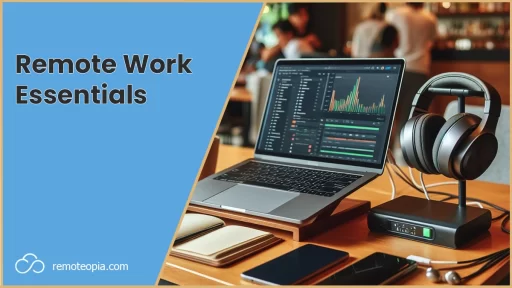
Getting the most out of a dispersed team can seem challenging at first.
Communication limitations, motivation and lack of transparency can be big factors in remote team productivity.
Here are some methods and ideas I’ve implemented to help foster a productive environment for my team.
Team Communication And Collaboration
To enhance your remote team’s productivity, it’s essential to optimize how you use communication tools, create synergy among team members, and build a transparent culture.
This focused approach ensures that your team collaborates effectively even from a distance.
Effective Use Of Communication Tools
Your choice and use of communication tools are the backbone of successful remote work.
Leveraging tools like Zoom for meetings allows for face-to-face interaction that can boost engagement and reduce misunderstandings.
Moreover, employing a mix of synchronous tools (like instant messaging apps) and asynchronous tools (such as email) can cater to different communication needs.
Teaching teams which tools to use for the most succinct way to communicate and derive answers can save hours of lost time.
Ensure you:
Fostering Team Synergy

Strong team synergy relies on structured and thoughtful communication.
Schedule meetings with a clear agenda to maximize time and enhance team collaboration.
Small habits can have a big impact, such as:
Building a Culture of Transparency
Transparency in remote teams builds trust and alignment.
Use collaboration tools to maintain an open line of communication and share updates frequently.
Your communication channels should promote openness, allowing team members to voice concerns and contribute ideas.
Implement practices like:
By focusing on these areas, you’re setting the stage for efficient and effective remote work, which is crucial in today’s work environment.
Employee Well-being And Engagement
To bolster remote team productivity, it’s essential to focus on enhancing your employees’ well-being and engagement.
Active steps to address feelings of isolation and prevent burnout can lead to improved motivation and accountability.
Addressing Isolation and Burnout

Consider establishing virtual coffee breaks or team-building activities where employees can interact in a relaxed atmosphere.
To prevent burnout, implement clear guidelines on work-life balance and encourage employees to disconnect after work hours.
Incorporate emotional support systems, such as offering access to mental health resources or setting up a peer support program.
Ensuring that your team feels supported on both professional and personal fronts can significantly reduce feelings of isolation and burnout.
Maintaining Motivation And Accountability
Setting clear expectations from the outset can maintain motivation and uphold accountability.
Clearly define work hours, project deadlines, and communication protocols.
You can use weekly check-ins to monitor progress and handle any emerging issues swiftly, keeping motivation high.
Encourage your team to set personal goals aligned with their roles, and recognize their achievements.
Publicly acknowledging accomplishments in team settings enhances engagement and spurs others to strive for similar recognition, contributing to a more motivated remote workforce.
Face To Face Offsites

If budgets and geography allow, a yearly offsite is a fantastic way to get everyone together, boost morale and camaraderie and reset for the year ahead.
Given the chance to bond with colleagues face to face and share business objectives that have a clear purpose and justify the work the team is doing can give a sense of direction that inspires teams and ultimately boosts their productivity.
There is value to face to face interaction that can’t be simulated virtually so use the time wisely to explore those gaps in communication and togetherness.
Great Leadership Practices
Managers must be adept at digital communication and foster an environment of trust and accountability to keep their team productive.
This will help you track progress and reinforce a sense of community among remote employees.
Ensuring Effective Onboarding And Retention
Onboarding remote employees requires a structured and attentive approach to instill a strong organizational culture.
Create a detailed onboarding checklist to streamline the process:
- Welcome video call to introduce new hires to the team.
- Access to essential digital tools and resources.
- Clear guidelines on work processes and company values.
Retention of remote employees hinges on continual engagement and opportunities for professional growth.
Listen to your employees’ feedback and be ready to make adjustments to the remote working model as needed to keep your team content and motivated.
Remote Team Productivity Conclusion
Every team is different, with different levels of experience and knowledge.
There’s not a one-size fits all approach to remote team productivity.
Being agile and taking time to get to know your team whilst catering holistic and individual methods to productivity will ultimately give you the best chances of getting the most out of your team.
Make sure to consider and appreciate their time and personal needs to ensure a good work-life balance is maintained – happy workers are productive ones!
Need more inspiration – check out these productivity quotes to get the creative juices flowing.
Frequently Asked Questions

James Waite
Founder of Remoteopia, James has worked in remote roles for 6 years. After a stint in recruitment, he now works as a director of website strategy in tech.




